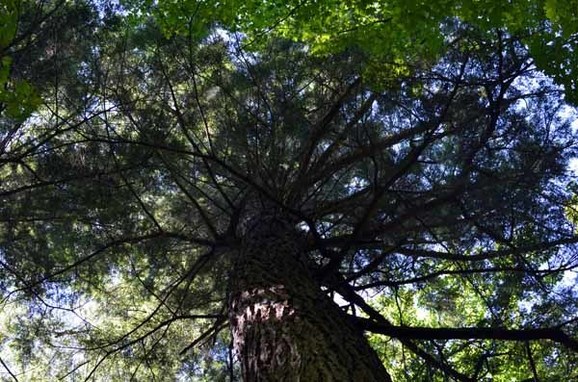
By JOANNE FOREMAN
Michigan Department of Natural Resources
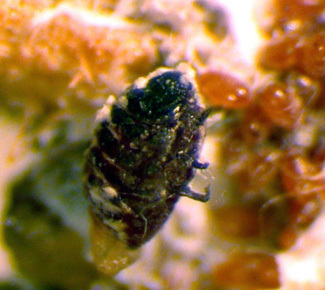 If you travel past Michigan’s cities, past the farms,
there’s a point where the billboards give way to forest land as far as the eye
can see.
This is the home of eastern hemlock – spanning from West
Michigan’s dunes, across the northern Lower Peninsula, into all but two
counties in the Upper Peninsula. (Click here to check out a sidebar column on hemlock in the U.P.)
Though not a standout, hemlock is an important part of the
mesic northern forest, providing shelter for deer and nesting birds, and
keeping forest streams cool and clean.
Now, the state’s hemlock resource, estimated at 170 million
trees, is threatened by a tiny invasive insect – the hemlock woolly adelgid.
|
The
threat
Nearly invisible to the naked eye, the black, aphid-like
bug pierces branches and feeds on sap, slowly sucking the life from the tree.
To protect its eggs, the adelgid spins a cotton-like, waxy
white ball. These “ovisacs,” resembling the tips of cotton swabs, are visible
on the underside of hemlock branches, near the base of the needles. It is the
woolly appearance of these ovisacs that help give the hemlock woolly adelgid its
name.
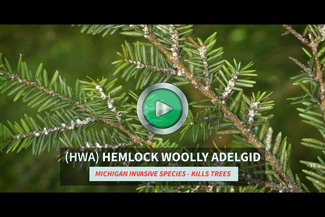 A native of Asia, the adelgid probably arrived in the U.S.
on a shipment of hemlock from Japan. It was first identified in Richmond,
Virginia in 1951 and by the 1980s had spread to large tracts of forest in the
Appalachian Mountains.
|
On the
move
Despite a 2001
external quarantine restricting the shipment of hemlock to Michigan
from states infested with the adelgid, the insect was detected in Emmet County,
just south of the Mackinac Bridge, in 2006.
Reports were then later confirmed in Macomb and Ottawa
counties in 2010, in Berrien County in 2012 and in Allegan County in 2013.
These small, localized infestations were managed by
surveying and removing infested trees and treating nearby trees with
insecticides. By 2015, just when these sites were receiving an “all-clear”
designation, reports of hemlock woolly adelgid were confirmed in new areas of
Ottawa County and in southern Muskegon County.
Surveys, and reports from the public, revealed infestations
in northern Muskegon County in 2016, and in Ottawa, Allegan and Oceana counties
in 2017. Not only private lands were affected, but also state parks in these
four western Lower Peninsula counties were found to have severe infestations.
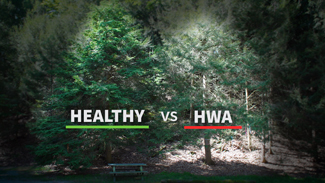 “Given the checkerboard pattern of hemlock woolly adelgid
across the western counties, it is likely that multiple introductions of
infested tree stock are responsible,” said Scott Lint, a forest health specialist
with the Michigan Department of Natural Resources.
Once it is introduced, the adelgids can be spread by wind,
wildlife and vehicles that brush against infested trees.
Coordinated
response
As the map of new infestations grew, the need for a
coordinated plan of action to battle this invasive species was clear.
Staff from the Michigan departments of Natural Resources
and Agriculture and Rural Development, Michigan State University, the U.S. Department
of Agriculture’s Forest Service, and the Ottawa County Parks and Recreation Department
formed the Hemlock Woolly Adelgid Coordinating Committee, which cooperatively completed
a statewide strategy document in August 2017.
Prevention
The Michigan Department of Agriculture and Rural
Development spearheads the first line of defense – prevention.
Along with the 2001 external quarantine, the department issued
an internal
quarantine in 2017, restricting the movement of hemlock tree nursery
stock and unprocessed hemlock products from, or within, Allegan, Muskegon,
Ottawa and Oceana counties.
Staffers provide education, certification and inspection
services to nurseries and producers handling hemlock in the quarantined
counties, and they train certified pesticide applicators on the proper use of insecticides
to treat hemlock wooly adelgids. The agriculture department staff also verifies
reports of adelgids detected in new locations.
|
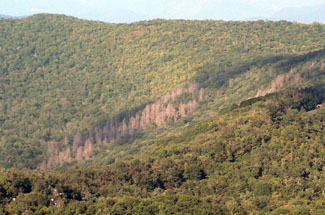 Detection
and response
The DNR’s Forest Resources and Parks and Recreation divisions are finding and treating hemlock woolly adelgid infestations on state
lands, including at Silver Lake, Duck Lake, Muskegon, P. J. Hoffmaster and
Grand Haven state parks – spanning the shoreline along these four affected
southwestern Michigan counties.
A recent grant from the U.S. Forest Service’s Landscape
Scale Restoration Program will expand outreach to local units of government in
affected areas and provide training to their staff.
Infestations on private and municipal lands in the
four-county area are being surveyed by the Ottawa Conservation District,
supported by funding from the Great Lakes Restoration Initiative, the Michigan
Invasive Species Grant Program and Ottawa County.
To keep information organized and efforts coordinated, all
partners use the same software for data collection.
All survey and treatment information is housed in one
database managed by the DNR that can be used by partners to inform decision-making and work flow.
Investigation
When invasive species arrive, they don’t come with a set of
instructions.
Knowing how they will respond to a newly encountered
environment, what they need to survive and whether they develop new behaviors
are important considerations in determining how best to control them.
Deborah McCullough, a professor in Michigan State University’s
departments of Forestry and Entomology, is at the center of a multifaceted
effort to understand the hemlock woolly adelgid’s life cycle in Michigan, its
response to insecticide treatments and the effects of Michigan’s winter
temperatures on its survival.
|
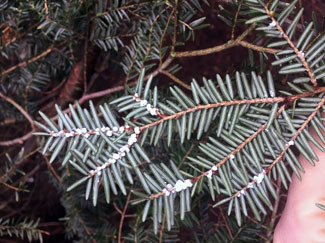 McCullough and her colleagues have already completed an adelgid
risk map, layering hemlock stands identified by satellite imagery over climate
data indicating temperatures favorable for adelgid survival.
The map directs survey crews to the most likely places hemlock
woolly adelgids might be found. Preliminary findings from treatment studies are communicated
with partners and contractors to improve results in the field.
“There are so many parts to managing an infestation –
research, funding, partnerships, survey, treatment,” McCullough said. “Working
together means we’re sharing information and moving each other forward, but at
the same time each of us is able to focus on our part of the task.”
The northern
line
Silver Lake State Park, in Mears, along the Lake Michigan
shoreline in Oceana County, is the most-northerly-known location of hemlock
woolly adelgid in Michigan.
Emma Fojtik and Katie Knapp, crew members with Ottawa
Conservation District’s adelgid project, perch halfway up the slope of a
forested dune on private property just south of the park.
They are mapping the location of every hemlock on the
property, recording each tree’s diameter and attaching a numbered tag to the
trunk. This prepares the site for chemical treatment to be applied by
contractors in the fall or spring.
|
 “Once we find an infested tree, every hemlock within 800
feet of the tree will be treated,” Knapp explains, as she gestures toward a
seedling full of white masses. “Basically, all of the hemlocks on this property
have hemlock woolly adelgids.”
Nearly identical work is happening at Silver Lake State
Park, where DNR staff is surveying and preparing for hemlock treatments.
“Our current strategy is based on the knowledge we have
now,” said James Wieferich, a technician with DNR Forest Resources Division.
“If adelgid infestations are limited to the areas we have surveyed, we can
create a barrier to sever the infestation from areas farther north that are not
infested and then stair-step treatment down to the southern limits (of the
infestation).”
North of the designated barrier, the Nature Conservancy –
in partnership with the Michigan Dune Alliance – will soon begin detection
surveys in coastal areas not known to be infested with adelgids.
Detection surveys are broadscale and quick, examining no
more than 30 trees per acre on selected plots to determine whether hemlock
woolly adelgids are present. These surveys will be conducted by Cooperative
Invasive Species Management Area staff – local partners who also assist by
providing outreach to communities affected by invasive species.
Signs
of hope
At a campground in Norton Shores in Muskegon County, an
early infestation site and ground zero for McCullough’s research, stands of
hemlock look gray and thin against the background of maples in full summer
flourish.
A closer look reveals a bright, vibrant hemlock trees among
the maples, tied with assorted colors of plastic marking tape. Another hemlock has
fresh, green growth at its tips. These trees are part of a study, funded by
MSU’s Project GREEEN, to improve treatment success for the insecticides Imidacloprid
and Dinotefuran.
Dinotefuran is fast-acting but short-lived, protecting
trees from adelgids for one to two years. Imidacloprid takes up to one year to
show results but provides protection for at least four years.
|
Armed with effective treatments and a coordinated
management strategy, Michigan hopes to be able to contain its hemlock woolly
adelgid infestation.
The Nature Conservancy’s Shaun Howard, project manager for
Eastern Lake Michigan, is cautiously optimistic.
“(Working together) we have more data to make decisions on
a broader scale,” Howard said. “Treatments are available and effective. Once
trees are infested, tree mortality could take four to 10 years, so we have time
to save the trees – but I can’t say whether this will be eradication (of the
infestations) or just the beginning of a long-term effort.”
McCullough is investigating the effects of temperature on
the adelgids – another factor that may improve the odds of success in the
battle against these invasive insects.
After an extremely cold night in Muskegon in January 2018,
80 percent of the hemlock woolly adelgids on a sample tree at the campground in
Norton Shores had died. Warmer temperatures on the same night at a site in
Ottawa county showed far less adelgid mortality.
“Michigan’s known infestations are along the lakeshore,
which has its own micro-climate,” McCullough said. “The lake effect means more
snow and generally warmer winter temperatures than our inland areas, which may
have an effect on the adelgids’ ability to survive and spread.”
Knowing what’s at stake – the significant environmental,
recreational and economic costs of losing Michigan’s hemlock trees – keeps the
team committed to working together to protect this valuable resource.
More information about hemlock, hemlock quarantines and identifying
and treating hemlock woolly adelgid is available at www.michigan.gov/hwa.
Check out
previous Showcasing
the DNR stories and subscribe to upcoming articles.
/Note to editors: Contact: John Pepin,
Showcasing series editor and coordinator, at 906-226-1352. Accompanying photos
are available below for download and media use. Suggested captions follow.
Credit: Michigan Department of Natural Resources, unless otherwise noted.
Adelgid: The hemlock woolly
adelgid is an invasive species in Michigan that came from Japan and damages eastern
hemlock trees. (Michael Montgomery, U.S. Department of Agriculture Forest
Service, Bugwood.org)
Branch: A hemlock tree branch
shows ovisacs that resemble wool, helping to give the insect its name.
Comparison: This image shows a
hemlock tree on the left that has not been infested with hemlock woolly adelgid.
The tree on the right is infested.
Damage: The defoliated eastern
hemlock trees in the center of the photo show damage from hemlock woolly
adelgids in the Great Smoky Mountains. (Ignazio Graziosi, University of
Kentucky, Bugwood.org)
Forest: Eastern hemlock trees
growing at Porcupine Mountains Wilderness State Park in Ontonagon County are shown.
The old-growth hemlocks here are part of the reason the forest was preserved as
a park.
Hemlock: A hemlock tree towers
to the sky at Porcupine Mountains Wilderness State Park in Gogebic County.
Sapling: A tagged eastern
hemlock sapling from Michigan's Lower Peninsula is shown./
|